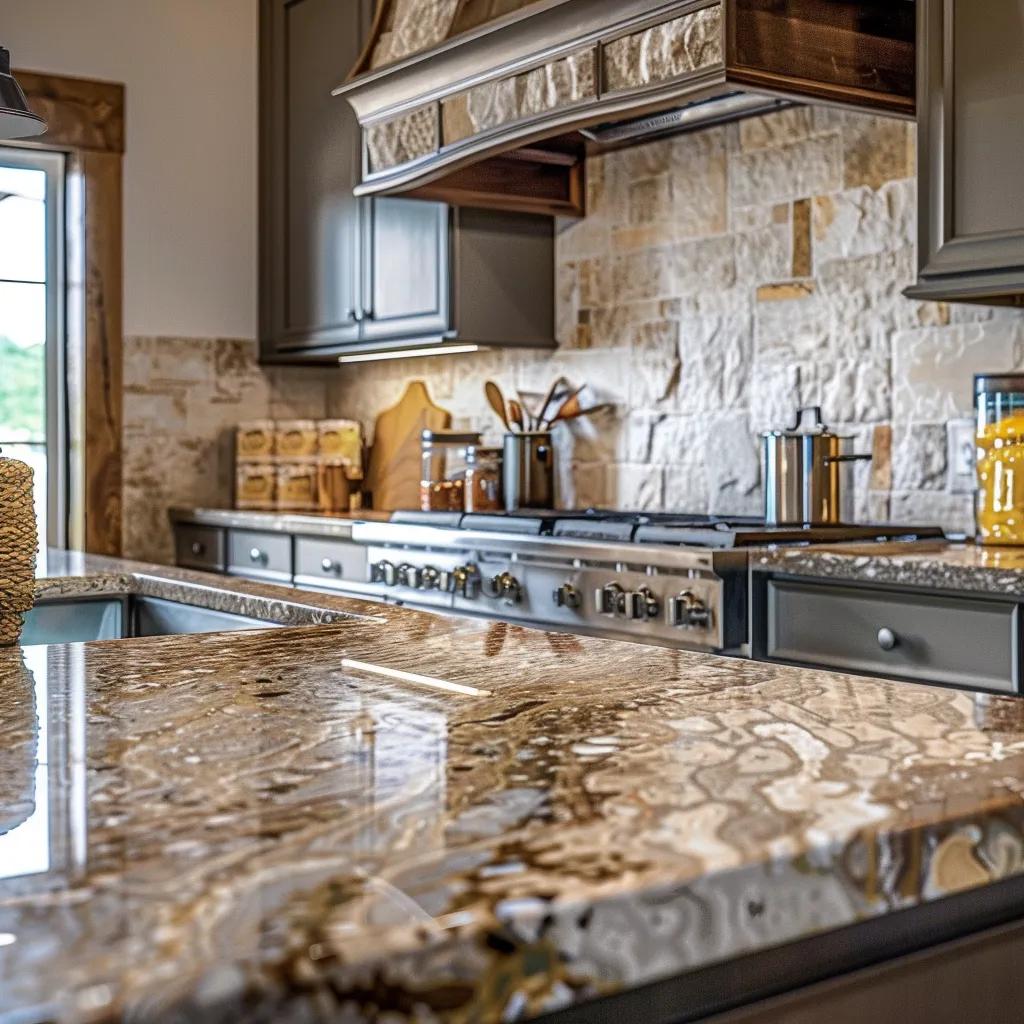When it comes to kitchen countertops in Alpharetta, the debate between quartz vs.granite countertops is a battle of beauty versus practicality—and your choice depends on lifestyle, budget, and design goals. Granite offers natural elegance with unique veining, while quartz provides unbeatable durability and low maintenance. But with Alpharetta’s mix of modern kitchens and busy households, factors like heat resistance, stain protection, and long-term value play a key role. In this guide, we’ll compare the pros, cons, and local trends for quartz vs.granite countertops, helping you decide which countertop truly belongs in your dream kitchen.
Quartz vs. Granite Countertops: Find the Perfect Match for Your Kitchen
What Are Quartz vs. Granite Countertops Made Of?
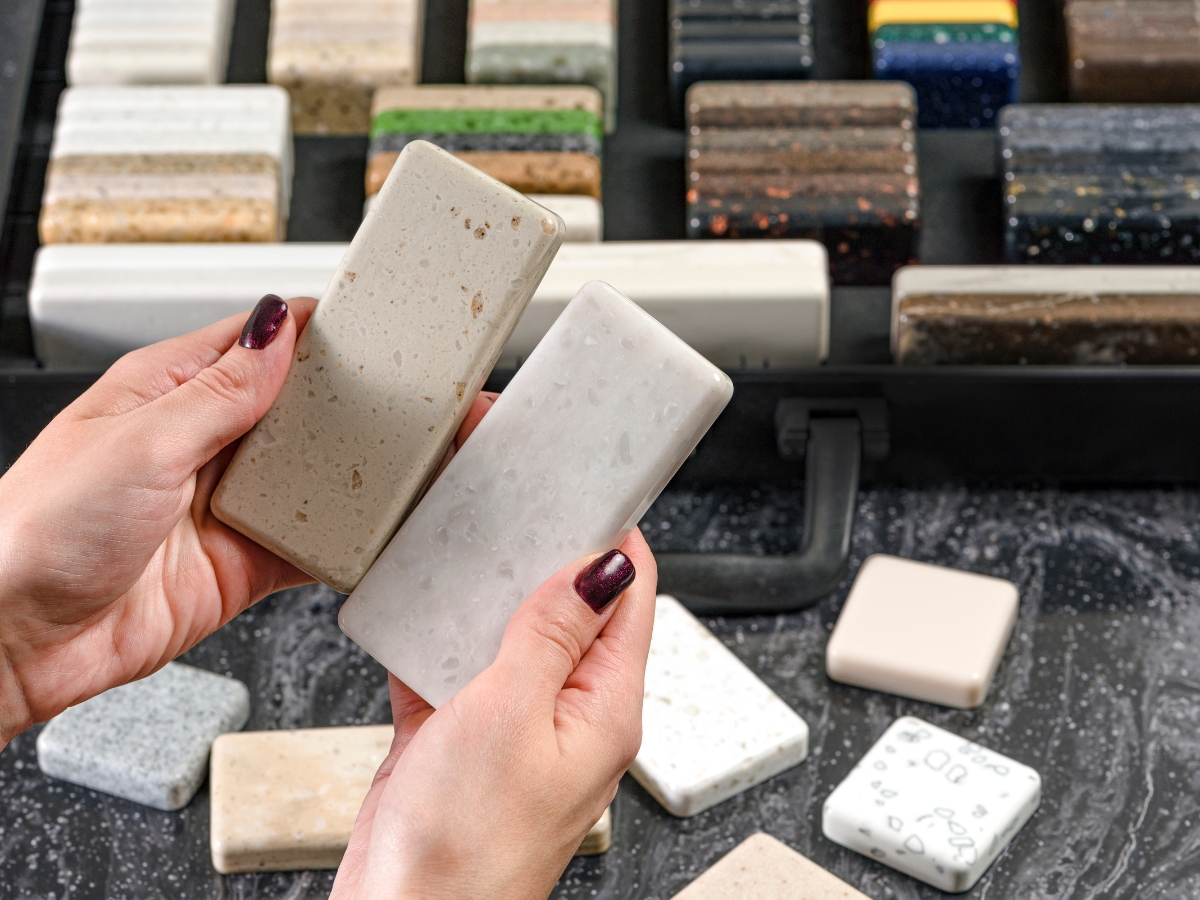
If you’re comparing quartz vs.granite countertops, it helps to start with what each material actually is. The two differ at the core, and those differences shape how they look, perform, and need to be maintained. Quartz is engineered from ground minerals and resins into a nonporous slab. Granite is a natural stone quarried in large blocks, cut into slabs, and finished for installation. Understanding that origin story makes the rest of the trade-offs easier to judge.
Quartz: How It’s Engineered
Quartz countertops are manufactured from about 90 to 95% ground quartz bound with 5 to 10% polymer resins and pigments. The mix is pressed under vibration, then cured with heat and pressure. Because the recipe and process are controlled, the result is uniform color and pattern from slab to slab. The surface is nonporous, so it resists liquid absorption and does not need sealing. Day to day, cleanup is simple with mild soap and water. Consistency is the main draw: if you want the same look across a large kitchen or multiple units, engineered quartz delivers it.
Granite: How It Forms In Nature
Granite is an igneous rock that forms as magma cools slowly underground. Over time, crystals of quartz, feldspar, and mica interlock, creating patterns that vary by quarry and even by block. Slabs are cut from the quarry block, then polished or honed. Because granite is porous, it benefits from periodic sealing to limit staining. In exchange, you get one-of-a-kind movement and mineral character that an engineered surface cannot duplicate. Heat tolerance is strong, but trivets are still smart to protect the finish and avoid thermal shock at seams.
Composition And What It Means In Use
Composition drives behavior. Quartz’s resin content creates a nonporous, consistent surface that is highly stain-resistant and easy to maintain. It can be sensitive to high heat, so plan to use trivets near cooktops and for hot pans. Granite’s mineral structure handles heat well and brings unique patterning to a space, but its pores mean sealing and prompt wipe-ups are part of ownership. For busy kitchens that see spills and frequent prep, quartz’s low maintenance is a plus. For homeowners who value natural variation and do not mind periodic sealing, granite delivers a classic stone look.
Appearance And Design Flexibility
Engineered quartz comes in a wide range of colors, from bright whites to deep charcoals, and can mimic marble veining with predictable repeat. Edge profiles, thicknesses, and finishes are consistent, which helps with tight installation schedules. Granite’s palette depends on the quarry. Some slabs read quiet and uniform; others show bold veining and crystals. If you want your counters to be a focal point, granite’s individuality can anchor the design. If you prefer a controlled, minimal backdrop, quartz makes that easy.
Care, Lifespan, And Cost Context
Both materials are durable when installed correctly on level cabinets with proper support. Everyday care is simple for each: gentle cleaners, soft cloths, and cutting boards to protect edges and blades. Quartz typically does not require sealing. Granite usually benefits from sealing at install and refresher coats over time, based on use and product directions. Pricing overlaps depending on brand, color, thickness, and fabrication complexity. Complex cutouts, mitered edges, and long spans can move either material into a higher bracket.
Aesthetic Appeal: How Do Quartz vs. Granite Countertops Differ in Appearance and Style?
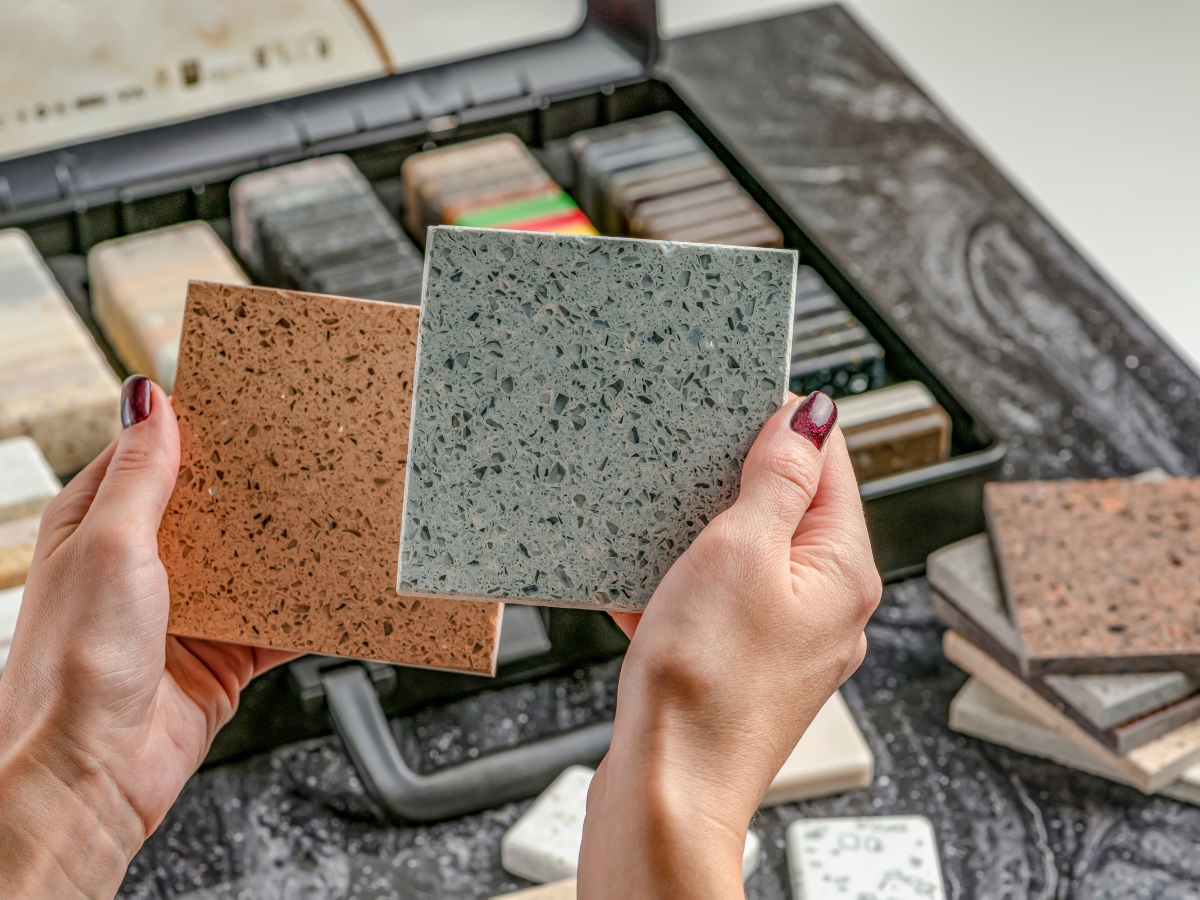
If you are weighing quartz vs.granite countertops, start with how each one looks in a real kitchen. Quartz is engineered, so the color and pattern are controlled from slab to slab. Granite is natural stone, which means every piece carries its own mineral map. That core difference shapes everything from veining to how seams read across an island.
What Are the Visual Characteristics of Quartz Countertops?
Quartz delivers consistency. Manufacturers blend ground quartz with resins and pigments, then press and cure the mix into slabs. The result is predictable color, repeatable veining, and tight quality control. Bright whites stay bright, soft greys stay soft, and the marble looks keep their long, gentle lines without surprise patches. That uniformity helps when you need multiple slabs for a large island and perimeter runs, because matching tones and patterns is straightforward. It also supports modern and transitional kitchens where clean planes and subtle movement are the goal. Finishes vary from polished to honed to softly textured, yet the overall read remains calm and even. If you want the counters to sit quietly behind statement cabinets or bold tile, quartz makes that easy.
What Unique Patterns and Colors Does Granite Offer?
Granite is cut from the earth, not made in a mold, so it brings natural variation. Quartz, feldspar, and mica crystals form over time and create veining, speckles, and shifts in tone that feel layered and dimensional. Some slabs are reserved and uniform. Others move with sweeping ribbons and scattered mineral flecks that catch the light. Color ranges from inky black to warm browns and cool blues, with earth tones that pair well with oak, walnut, and painted cabinetry. Because no two slabs are the same, selection happens at the slab yard, not from a sample chip. You pick the exact pieces, plan the cut, and decide how seams will meet the pattern. For many homeowners, that one-of-a-kind result is the point.
Which Look Works Best In Today’s Homes?
Both materials fit Midtown and suburban kitchens, just with different roles. Minimal or Scandinavian spaces often lean toward pale quartz that keeps sightlines clean and amplifies daylight. Industrial or contemporary designs can go either direction, using charcoal or black quartz for a monolithic look, or a dark, fine-grained granite for depth without visual noise. Classic and eclectic kitchens benefit from the character of granite, especially when the stone becomes a focal point on an island while perimeter tops stay quieter. If you like marble but want fewer upkeep steps, a marble-look quartz offers long veining and a soft background without unpredictable patches.
Practical Style Tips When You Choose
See full slabs before you commit, so scale and movement match your room size. For quartz, verify that the pattern repeat suits long runs and that seams will not interrupt a major vein. For granite, map seam locations on the slab and consider bookmatched pieces if you want mirrored movement on a wide island. Coordinate sheen levels across surfaces. A honed counter, a satin cabinet finish, and a matte backsplash create a cohesive, low-glare look that photographs well and hides everyday smudges. Tie the counter to flooring with a shared undertone so the room reads as one space rather than separate zones.
Enduring Beauty: How Durable Are Quartz vs. Granite Countertops for Alpharetta Kitchens?
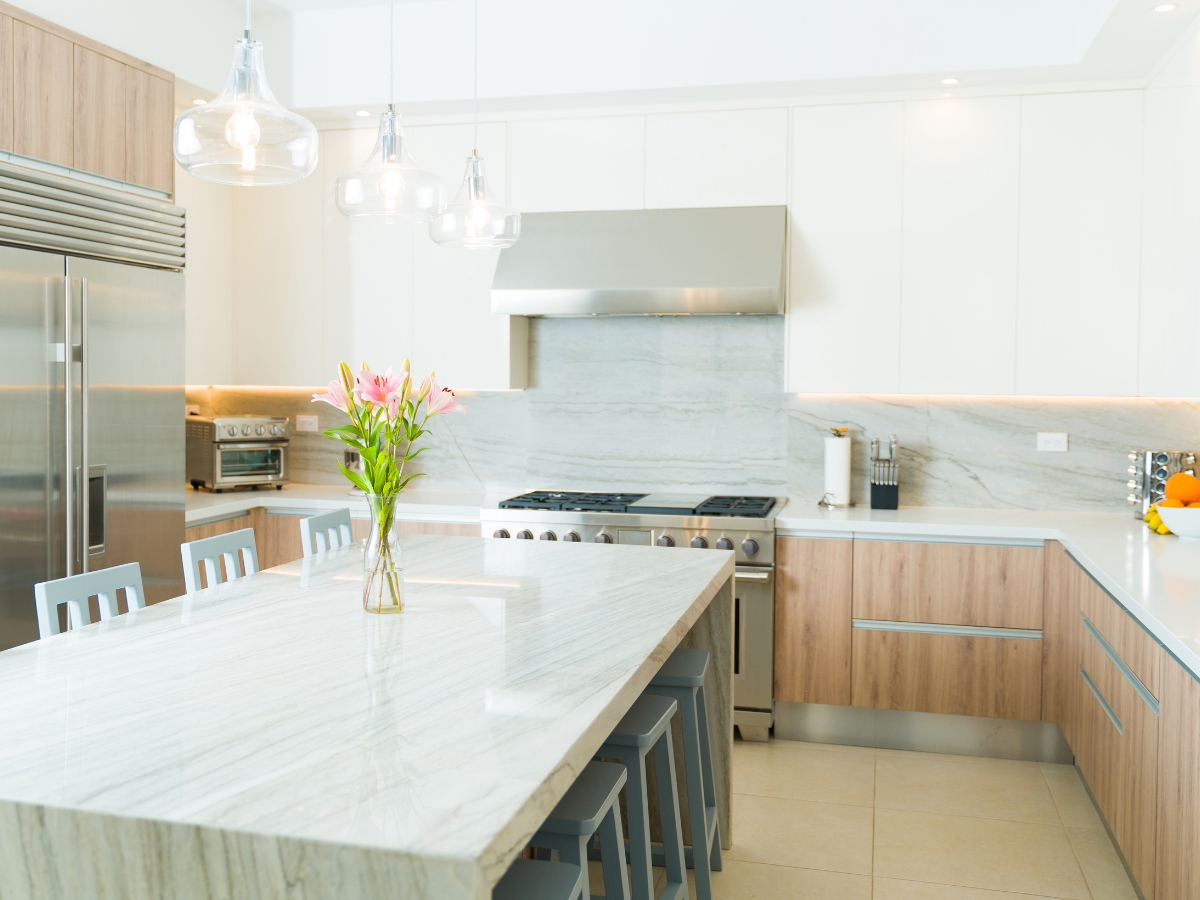
When comparing quartz vs.granite countertops, durability often makes the decision. Both hold up in busy homes, but they behave differently. Quartz is engineered and nonporous, which makes day-to-day care simple. Granite is a natural stone with strong mineral hardness and excellent heat tolerance. Knowing how each surface handles stains, scratches, and heat will help you match the material to how your kitchen is actually used.
What Makes Quartz Durable and Low Maintenance
Quartz counters are made from ground quartz, resin, and pigment pressed into slabs. The result is a nonporous surface that resists stains from coffee, wine, and cooking oils. Because liquids cannot penetrate, routine sealing is not required, and a mild cleaner with water handles most messes. The high mineral content provides good scratch resistance against everyday utensils and stray grit on cutting boards. Like any rigid surface, edges can chip if hit hard, so basic care still matters. Heat is the main caution: prolonged or extreme heat can discolor resin, so set a trivet near the cooktop and for pans coming straight from the oven. If your priority is fast cleanup and predictable performance, quartz fits well.
How Granite Handles Heat and Wear
Granite forms as magma cools slowly underground, creating interlocked crystals of quartz, feldspar, and mica. On the Mohs scale, it typically measures around 6 to 7, which means it stands up well to abrasion from normal kitchen tasks. Granite also tolerates brief contact with hot cookware better than many man-made surfaces. Because it is porous, spills can darken the stone if they sit. Sealing at installation and periodic resealing reduces that risk and makes cleanup easier. Prompt wipe-ups and a simple stone cleaner keep the finish looking fresh. With those habits, granite maintains its polish and structure for years while bringing the depth and variation only natural stone provides.
Which Surface Works Best For Busy Alpharetta Households
Let your habits lead. If your kitchen sees constant cooking, quick wipe-downs, and you prefer not to think about sealing, quartz is the straightforward option. It delivers uniform color across large islands and perimeter runs, and it keeps maintenance light. If you move hot pots often or prefer a natural focal point with unique mineral patterning, granite is a strong match. It asks for sealing on a schedule and sensible care with spills, but rewards that effort with a one-of-a-kind look and solid heat performance.
Simple Care Routines That Preserve Value
Both materials last when installed on level cabinets with proper support. Use cutting boards to protect edges and your knives. Clean with pH-neutral products rather than abrasives. For granite, check the sealer once a year by placing a few drops of water on the surface; if the spot darkens, it is time to reseal. For quartz, avoid harsh solvents and keep direct high heat off the surface. Address chips or loose seams promptly so small issues do not grow.
Bottom Line
Quartz keeps maintenance low and color consistent. Granite offers natural variation and better tolerance for brief heat. Either can serve a high-use Alpharetta kitchen well. Choose the surface that aligns with how you cook, clean, and live day to day, and you will get long, reliable service and a counter you enjoy seeing every time you walk in.me.
Effortless Care: What Are the Maintenance Requirements for Quartz vs. Granite Countertops?
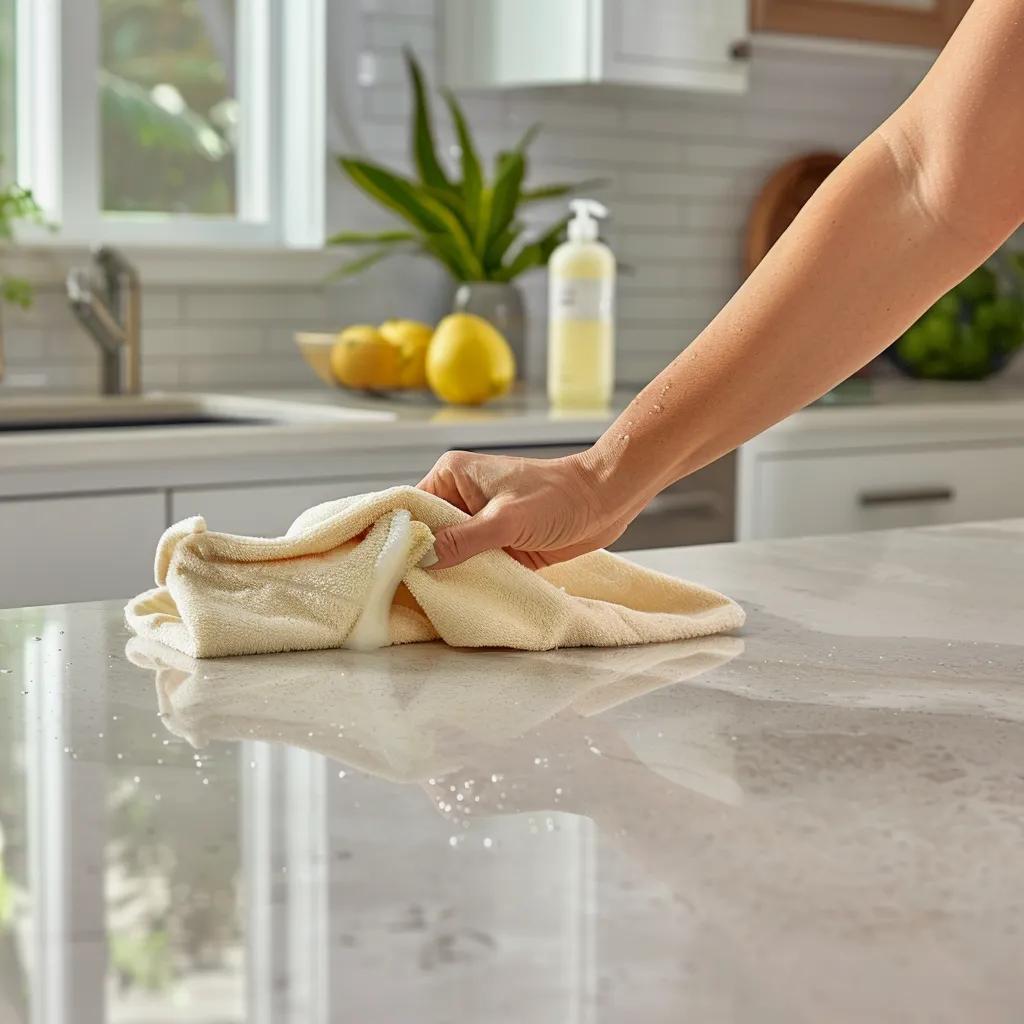
Understanding the maintenance involved is crucial for ensuring the long-term value and beauty of your investment. Quartz requires remarkably simple cleaning, offering a truly low-maintenance solution. Granite, however, demands scheduled sealing and diligent stain prevention to preserve its natural allure. Alpharetta homeowners should fully understand these routines before making the investment in their ideal countertop, ensuring lasting satisfaction.
How To Clean And Maintain Quartz
Quartz is an engineered surface made from ground quartz, resins, and pigment. Daily care is straightforward. Wipe with a soft cloth and mild dish soap in warm water, then dry to prevent water spots. For sticky residue, a plastic scraper used gently will lift the spill without scratching. Avoid abrasive pads and harsh solvents, which can dull the finish. Most brands advise keeping strong chemicals and high heat away from the surface. Use trivets near cooktops and place hot pans on a pad so the resin binder is not exposed to prolonged heat.
Sealing is not part of quartz care because the material is nonporous. That makes it resistant to staining from coffee, oil, and wine when spills are cleaned in a reasonable time. If you notice a light film from hard water, a nonabrasive glass cleaner or a mix of mild dish soap and water on a microfiber cloth will restore clarity. Rinse and dry afterward so minerals do not leave spots.
How Often Granite Should Be Sealed And Cleaned
Granite is a natural stone. It resists wear well, but its pores can hold liquids if spills sit too long. Plan to seal at installation and refresh the sealer as needed. A simple water test once a year tells you if it is time: place a few drops on the surface and check after 10 to 15 minutes. If the stone darkens, reapply a penetrating sealer. Many kitchens do well with a 12 to 18 month cycle, but frequency depends on use, color, and product.
For daily cleaning, use a pH-neutral stone cleaner or mild soap and water, then dry the surface. Avoid acidic cleaners and abrasives. Wipe up oil, wine, and colored sauces promptly so pigments do not wick into the stone around sink edges or along seams. Trivets are still a smart practice to protect finishes and seam areas from thermal shock, even though granite handles heat better than most materials.
Common Maintenance Challenges And Practical Fixes in Quartz vs. Granite Countertops
Quartz can show faint water spots or a matte patch if harsh cleaners are used. Stick to nonabrasive products and rinse well to prevent film buildup. Permanent marker or tough residue responds to a small amount of isopropyl alcohol on a soft cloth, followed by a soap-and-water wipe.
Granite may show dark rings or lines when the sealer wears thin. Re-sealing usually remedies light staining; deeper stains may need a poultice recommended for natural stone. Small edge chips can occur if a heavy pot strikes the counter. Many fabricators can fill and blend these spots during a service visit, so addressing them early keeps the edge clean and strong.
Choosing Based On How You Live
Pick the surface that fits your habits. If you want fast cleanup, no sealing, and consistent color, quartz keeps maintenance low. If you prefer a natural look with strong heat tolerance and do not mind a simple sealing routine, granite is a reliable choice. With basic care—soft cloths, gentle cleaners, prompt wipe-ups, and protection from extreme heat—both materials will hold their finish and function through years of cooking and entertaining.
Investment & Value: How Do Quartz vs. Granite Countertops Compare in Cost and Value for Alpharetta Homes?
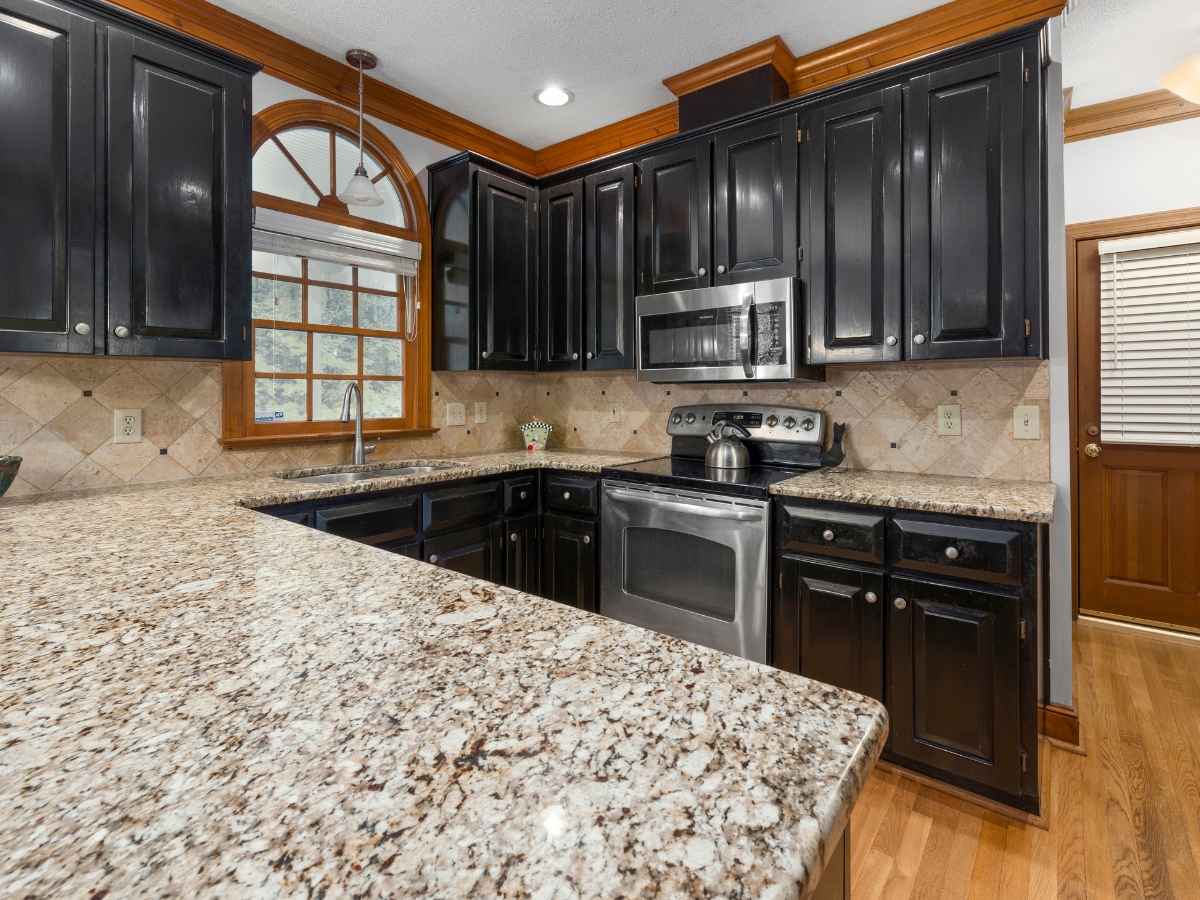
In the process of choosing quartz vs.granite countertops for an Alpharetta kitchen, price and long-term value are usually the tiebreakers. Both materials are premium choices that buyers recognize, but their costs and what drives those costs are a little different. Understanding the ranges, the factors that push a quote up or down, and how each option affects resale will help you set a realistic budget and choose a surface that pays off.
Typical Pricing for Quartz
Installed quartz in the Alpharetta area commonly runs from $55 to $125 per square foot. Where a project lands inside that range depends on several items. Color and pattern complexity can increase the slab price, especially marble looks with long veins. Thickness, edge profiles, sink and cooktop cutouts, and any waterfall panels add fabrication time. Slab yield also matters. If your layout forces extra seams or leaves large offcuts, waste goes up and so does the total. Site conditions play a part as well. Tight stairwells, long carries, or limited elevator access can add handling time that shows up in the labor line.
Typical Pricing for Granite
Installed granite often ranges from $50 to $140 per square foot. The spread comes from rarity and movement in the stone, country of origin, finish, and the work needed to align seams with the vein pattern. Thicker material and eased or mitered edges cost more to fabricate. As with quartz, the number of cutouts, backsplash details, and on-site constraints influence the final bill. Granite pricing can be attractive for widely available colors, while rare slabs or heavy pattern matching can exceed mid-tier quartz.
What Those Quartz vs. Granite Countertops Prices Mean for Resale
Both materials signal quality to buyers and can lift the appeal of a listing. Quartz’s consistent color and low maintenance read as turnkey, which helps in contemporary or transitional homes. Granite brings natural variation and depth that many buyers still view as a luxury finish. In competitive suburbs like Alpharetta, updated stone counters can help a home show better and sell faster. Market reports in many areas place the potential price lift for well-executed kitchen updates with stone surfaces in the 2 to 4 percent range, though actual return depends on the overall condition of the home and neighborhood comps. The strongest value comes when the countertop choice fits the style and price point of the property and is paired with clean cabinetry, reliable appliances, and good lighting.
Budget Planning Tips That Protect Value
Keep layout changes minimal if you want to control cost. Moving sinks or cooktops adds plumbing and electrical work and can require extra slabs. Choose an edge profile that suits the style of the home without adding unnecessary fabrication time. For quartz, mid-tier colors with subtle movement often deliver a high-end look without the premium of the newest patterns. For granite, select slabs in person so you can confirm movement and plan seam locations that respect the pattern. In either case, confirm that quotes include templating, delivery, installation, and finishing details so you are comparing like for like.
Heat Performance: How Do Quartz vs. Granite Countertops Perform Against Heat in Alpharetta Kitchens?
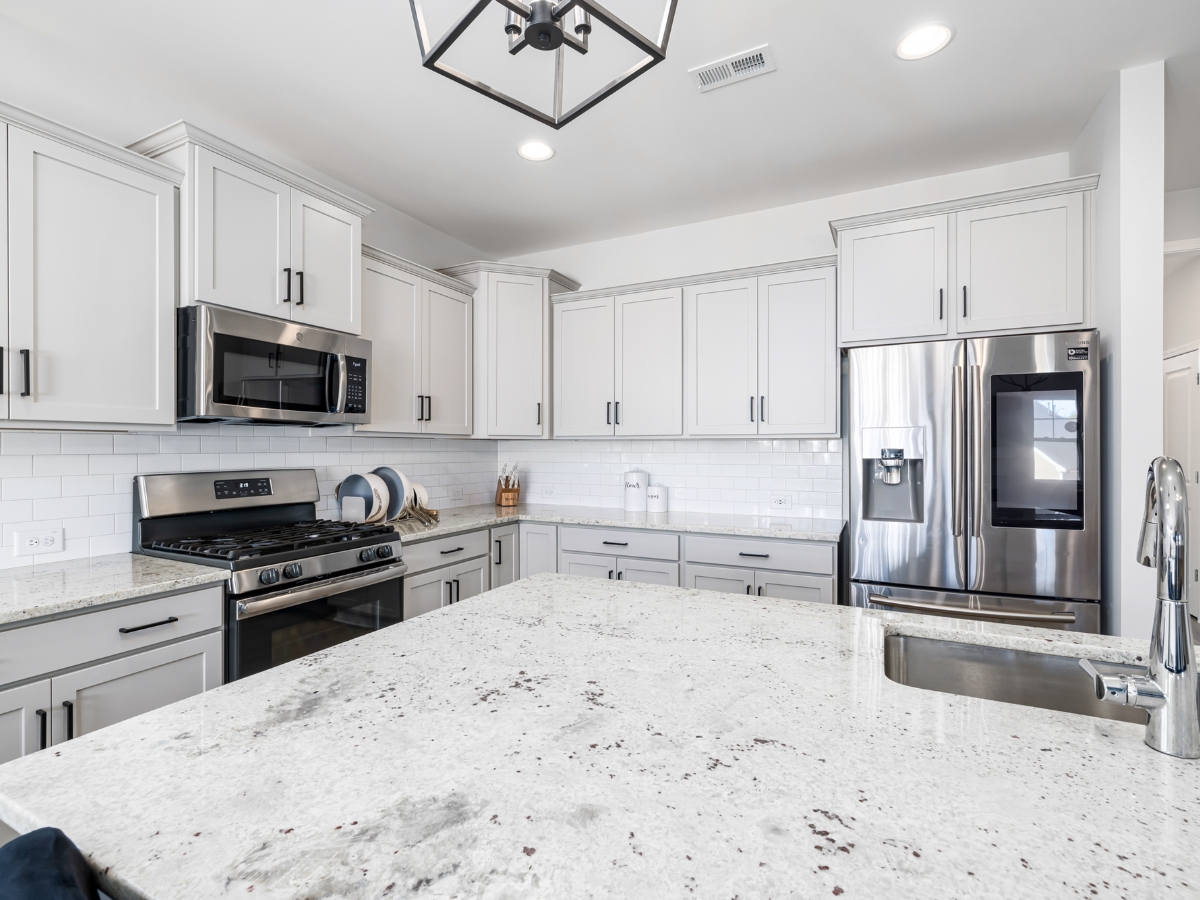
Heat behavior is a key divider in quartz vs.granite countertops. Granite tolerates brief, direct contact from hot pans better, while quartz benefits from trivets to protect its resin binder. Plan a landing zone near the range, and both materials will stay in good shape.
Why Granite Handles Heat Better
Granite forms as molten rock cools slowly underground, locking quartz, feldspar, and mica into a dense, stable structure. That mineral makeup gives granite strong resistance to brief, direct heat. Setting a hot skillet down for a short period is less likely to mark or discolor a properly installed and supported granite top. Many homeowners choose granite for island zones near a range because it tolerates the occasional hot pot without drama. Even with that advantage, smart habits still apply. Use trivets around seams and near overhangs, since concentrated heat at a joint can stress the adhesive or the stone edge. Wipe spills quickly, especially oils and acidic sauces, so heat does not help drive pigments into pores. Periodic sealing helps the surface shed liquids and makes cleanup easier.
What Are Quartz’s Heat Limits
Quartz counters are made from ground quartz bound with polymer resins and pigments, then pressed and cured into slabs. The nonporous result resists stains and needs no sealing, but the resin component sets the heat ceiling. Prolonged contact with very hot cookware can discolor or dull the finish, and sharp thermal shock can cause small cracks, particularly at cutouts and edges. Day to day, quartz holds up well beside a cooktop and under small appliances, but it benefits from trivets and hot pads when you move a pan straight from the oven or a pot just off a burner. Treat high heat as you would with many other composite materials: protect the surface and avoid leaving hot objects in one spot.
Practical Precautions When Considering Quartz vs. Granite Countertops
Plan your workspace so heat protection is automatic. Keep two trivets or a pull-out heat-resistant board near the range and oven. On granite, use them at seams and polished edges to reduce focused stress. On quartz, use them any time cookware is truly hot to the touch. For both materials, allow cookware to cool briefly on the stove before it reaches the counter. In bake-heavy kitchens, consider a designated landing zone with a metal trivet integrated into the island. Around sinks, avoid shocking either surface by moving a hot pot directly into cold water; let it cool a bit first.
Real-World Tips For Alpharetta Kitchens
Match material choice to how you cook. If you regularly sear in cast iron and move pans fast, granite near the range can simplify your routine. If quick cleanup matters more than brief, direct heat contact, quartz on primary prep runs keeps maintenance light. Many homeowners mix surfaces, using granite or a heat-tolerant stone insert at a hot zone and quartz elsewhere for a consistent look with easier care.
Granite offers stronger tolerance for short, direct heat. Quartz delivers low maintenance but needs protection from very hot items. With basic habits like using trivets, wiping spills promptly, and avoiding thermal shock, both materials will keep their finish and shape through years of cooking. Choose the surface whose heat behavior aligns with how you cook, and your countertops will stay attractive and functional long term.
Quartz vs. Granite Countertops: Which Countertop Material Is Best Suited for Your Alpharetta Lifestyle?
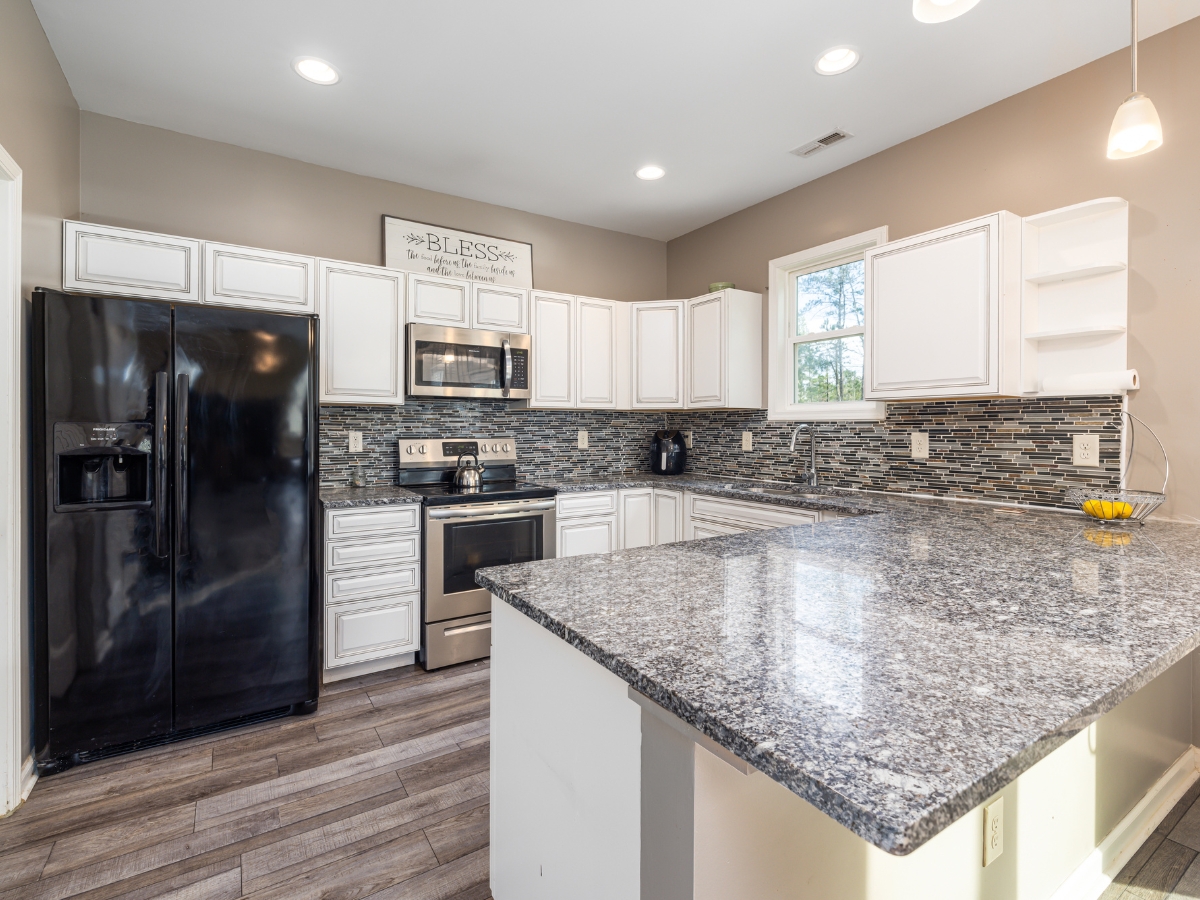
Choosing a countertop is less about hype and more about fit. The right surface should match how you cook, clean, and entertain, and it should look the way you want your kitchen or bath to feel every day. A useful way to frame quartz vs.granite countertops is to map their strengths to your routines, then check that choice against your budget and design goals.
Key Factors To Weigh Before You Decide On Quartz vs. Granite Countertops
Start with maintenance. Quartz is nonporous, so routine care is simple soap, water, and a soft cloth. Granite is porous by nature, which means it benefits from sealing on a sensible schedule and quick wipe-ups after spills. If you prefer low-touch care, quartz has the edge. If a little routine sealing is fine with you, granite stays in play.
Think about heat. If hot pans often move straight from the range to the counter, granite’s mineral structure tolerates brief, direct heat better. Quartz handles everyday prep well, but protect it from very hot cookware with trivets or a short cool-down on the stove.
Consider the look. Quartz offers steady color and controlled veining from slab to slab, which helps when you want a calm, uniform backdrop. Granite brings one-of-a-kind mineral movement and depth that can turn an island into the focal point. Pick the visual story that matches your cabinets, flooring, and lighting.
Budget and value matter too. Installed prices overlap depending on color, thickness, edge details, and cutouts. Mid-range quartz lines are predictable on cost and availability. Granite can be cost-effective in common colors and climb in price for rare patterns or heavy movement. In resale terms, both read as premium finishes in Alpharetta, especially when paired with clean cabinetry and good lighting.
Matching Material To Room And Use
Kitchen islands work hard. For family meals and frequent prep, quartz keeps cleanup fast and resists stains from coffee, wine, and oils. In hot zones near a range, granite’s tolerance for brief direct heat can simplify your workflow. Many homeowners mix the two, using a heat-friendly section where pans land and quartz on the perimeter for a consistent, low-maintenance finish.
Bathroom vanities see water, cosmetics, and cleaners. Quartz’s nonporous surface resists absorption and does not need sealing, which makes day-to-day care straightforward. Granite adds natural character and pairs well with warm metals and stone-look tile. If you choose granite for a bath, sealing at install and light maintenance keep the surface looking fresh.
Bar tops and casual seating areas benefit from surfaces that hide fingerprints and handle spills. Honed or matte finishes in either material reduce glare and smudges under evening light. Quartz offers uniform color across long runs. Granite can serve as a conversation piece when you select a slab with distinctive veining.
A Simple Way To Finalize Your Choice
Write down your top priorities in order: low maintenance, heat handling, visual character, and budget. Circle the top two. If low maintenance and uniform color lead, quartz is likely the better fit. If heat handling and natural variation are the top drivers, granite is the stronger match. Confirm by viewing full slabs, planning seam locations, and checking that the finish and edge profile suit your cabinets and hardware.
Your Questions Answered: FAQs About Quartz vs. Granite Countertops
Alpharetta homeowners often have direct questions to guide their selection process. Below, you’ll find clear, concise answers to the top queries, helping you make the best choice for your home.
Is Quartz Better Than Granite for Kitchen Countertops?
Neither is inherently “better”; they simply excel in different areas. Quartz’s engineered resin-bonded composition makes it remarkably stain-resistant and easier to maintain, offering consistent beauty. Granite’s natural hardness and higher heat tolerance make it more resilient against hot cookware and provide a unique, organic aesthetic. Your ultimate choice depends on whether low upkeep and uniformity or superior heat performance and natural variation rank higher in your priorities.
What Are the Disadvantages of Quartz Countertops?
- Sensitive to extreme heat above 300°F, requiring trivets or hot pads.
- Visible seams can be more noticeable in complex or very large layouts.
- Potential for UV-induced color fading if consistently exposed to direct, intense sunlight over long periods.
What Are the Disadvantages of Granite Countertops?
- Porous surface requiring professional sealing approximately every 12–18 months to prevent stains.
- Natural variations in pattern and color can complicate matching slabs for very large or multi-slab projects.
- Potential for minor chipping at edges under heavy impact, though generally very durable.
Which Countertop Is More Expensive: Quartz or Granite?
The cost can vary. In Alpharetta, quartz generally ranges from $55–$125 per square foot installed, whereas granite typically ranges from $50–$140 per square foot. The final cost is primarily determined by specific slab rarity, brand, and the complexity of fabrication and installation details.
Does Granite Need to Be Sealed Regularly?
Yes, absolutely. Granite requires professional sealing roughly every 12–18 months. This crucial step blocks its natural porosity, preventing stains from oils, wine, and acidic liquids, which is especially important in Alpharetta’s humid environment.
Does Quartz Stain Easily?
No, quite the opposite. Quartz’s non-porous engineered surface is highly resistant to staining from common kitchen culprits like coffee, wine, and oils. Spills can typically be wiped away effortlessly with mild soap and water, making it a truly low-maintenance and stain-proof option for your home.
Both quartz vs. granite countertops offer lasting beauty and exceptional performance when chosen to perfectly match your lifestyle and care preferences. Take the time to evaluate their composition, style, durability, maintenance, cost, and heat resistance. Then, partner with Kitchen and Bath by Zeus for expert guidance and flawless installation, bringing your dream kitchen to life in Alpharetta.
Conclusion
Choosing between quartz vs. granite countertops comes down to your lifestyle, budget, and design vision—but either option can elevate your Alpharetta home with beauty and durability. At Kitchen and Bath by Zeus, we help homeowners make confident decisions with expert guidance for their kitchen remodeling project with premium materials and precision installation. Schedule your free consultation today by calling 404-602-2668 or filling out our online form—let’s create a kitchen or bath that combines timeless appeal with everyday functionality.


